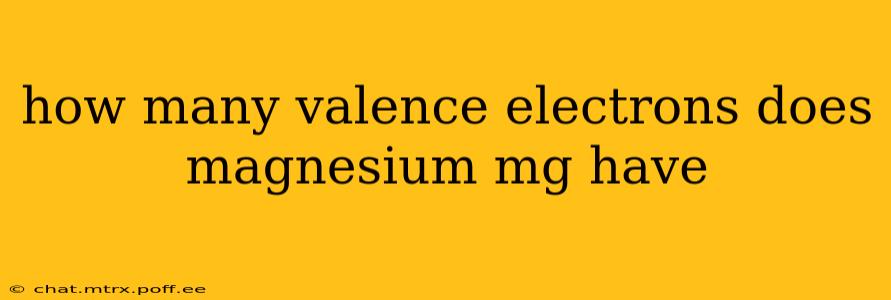How Many Valence Electrons Does Magnesium (Mg) Have?
Magnesium (Mg), a vital element in human biology and various industrial applications, possesses two valence electrons. Understanding valence electrons is crucial for predicting an element's chemical behavior and its ability to form bonds with other elements. This article will delve into the specifics of magnesium's electron configuration and explain why it has only two valence electrons.
What are Valence Electrons?
Before we get to magnesium's specific number, let's define valence electrons. Valence electrons are the electrons located in the outermost shell (or energy level) of an atom. These electrons are the most loosely held and, therefore, are the ones most likely to participate in chemical reactions, forming bonds with other atoms. The number of valence electrons determines an element's reactivity and the types of chemical bonds it can form (ionic, covalent, metallic).
Magnesium's Electron Configuration: Unveiling the Valence Electrons
Magnesium's atomic number is 12, meaning it has 12 protons and 12 electrons in a neutral atom. The electron configuration of magnesium is 1s²2s²2p⁶3s². This configuration tells us how the electrons are distributed among the different energy levels and sublevels within the atom.
- 1s²: Two electrons occupy the first energy level (closest to the nucleus).
- 2s²2p⁶: Eight electrons fill the second energy level (2s and 2p sublevels).
- 3s²: The remaining two electrons reside in the third energy level's s sublevel.
It's the electrons in the outermost energy level (the highest principal quantum number, in this case, n=3) that are considered valence electrons. Therefore, magnesium has two valence electrons.
Why are Magnesium's Valence Electrons Important?
The presence of only two valence electrons significantly influences magnesium's chemical properties. Magnesium readily loses these two valence electrons to achieve a stable, filled outer electron shell (like that of a noble gas). This electron loss results in the formation of a Mg²⁺ ion, a cation with a +2 charge. This tendency to lose electrons makes magnesium highly reactive, especially with nonmetals like oxygen and chlorine. This reactivity explains why magnesium is used in various applications, such as:
- Lightweight alloys: Its low density and reactivity make it suitable for alloys in the automotive and aerospace industries.
- Grignard reagents: Organomagnesium compounds are vital reagents in organic chemistry for carbon-carbon bond formation.
- Dietary supplement: Magnesium is an essential mineral for numerous biological processes in living organisms.
How Does Magnesium Form Bonds?
Magnesium's two valence electrons dictate the types of bonds it forms. Because it readily loses these electrons, magnesium predominantly forms ionic bonds with nonmetals. In these bonds, magnesium transfers its two electrons to a nonmetal atom, creating electrostatic attraction between the positively charged magnesium ion (Mg²⁺) and the negatively charged nonmetal ion.
What are some common compounds of magnesium?
Magnesium's reactivity leads to the formation of several important compounds. Some common examples include magnesium oxide (MgO), magnesium chloride (MgCl₂), and magnesium hydroxide (Mg(OH)₂). These compounds arise from magnesium's ability to readily lose its two valence electrons to form ionic bonds with the respective anions.
In conclusion, magnesium (Mg) possesses two valence electrons, a key factor in determining its chemical behavior and reactivity. Understanding this fundamental aspect of its electronic structure allows us to predict its participation in chemical reactions and its wide range of applications.
